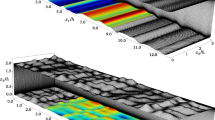Abstract
This paper reports velocity measurements obtained on a smooth and two geometrically different types of rough surfaces in an open channel. The measurements were obtained using a laser-Doppler anemometer. The recent boundary layer theory proposed by George and Castillo (1997) and conventional scaling laws are used to analyze the data. The present flow shows a strong structural similarity to a canonical turbulent boundary layer in the inner layer. The results demonstrate that surface roughness increases the wake parameter. Surface roughness also enhances the levels of turbulence intensities, Reynolds shear stress and triple correlations over most of the boundary layer, but decreases the stress anisotropy.






Similar content being viewed by others
References
Bandyopadhyay PR (1987) Rough-wall turbulent boundary layers in the transition regime. J Fluid Mech 180:231–266
Bergstrom DJ, Kotey NA, Tachie MF (2002) The effects of surface roughness on the mean velocity profile in a turbulent boundary layer. J Fluids Eng 124:664–670
Bergstrom DJ, Tachie MF, Balachandar R (2001) Application of power laws to low Reynolds number boundary layers on smooth and rough surfaces. Phys Fluids13:3277–3284
Coles DE (1956) The law of the wake in the turbulent boundary layer. J Fluid Mech 1:191–226
DeGraaff DB (1999) Reynolds number scaling of the turbulent boundary layer on a flat plate and on swept and unswept bumps. Dissertation, Department of Mechanical Engineering, Stanford University
Eriksson JG, Karlsson RI, Persson J (1998) An experimental study of a two-dimensional plane wall jet. Exp Fluids 25:50–60
George WK, Castillo L (1997) Zero pressure gradient turbulent boundary layer. Appl Mech Rev 50:689–729
Grass AJ (1971) Structural features of turbulent flow over smooth and rough boundaries. J Fluid Mech 50:233–255
Hama FR (1954) Boundary layer characteristics for smooth and rough surfaces. Trans Soc Naval Arch Marine Eng 62:333–358
Johnson PL, Barlow RS (1990) Effect of measuring volume length on two-component laser velocimeter measurements in a turbulent boundary layer. Exp Fluids 8:137–144
Krogstad PA, Antonia RA (1999) Surface roughness effects in turbulent boundary layers. Exp Fluids 27:450–460
Krogstad PA, Antonia RA, Browne LWB (1992) Comparison between rough- and smooth-wall turbulent boundary layers. J Fluid Mech 245:599–617
Mazouz A, Labraga L, Tournier C (1998) Anisotropy invariant of Reynolds stress tensor in a duct flow and turbulent boundary layer. J Fluids Eng 120:280–284
Mills AF, Hang X (1983) On the skin friction coefficient for a fully rough flat plate. J Fluids Eng 105:364–365
Nezu I, Nakagawa H (1993) Turbulence in open-channel flows. Balkema, Rotterdam
Nezu I, Rodi W (1986) Open-channel flow measurements with a laser Doppler anemometer. J Hydr Eng 112:335–355
Raupach MR, Antonia RA, Rajagopalan S (1991) Rough-wall turbulent boundary layers. Appl Mech Rev 108:1–25
Rodi W, Mansour NN, Michelassi V (1993) One-equation near-wall turbulence modeling with the aid of direct simulation data. J Fluid Eng 115:196–205
Shafi HS, Antonia RA (1995) Anisotropy of the Reynolds stresses in a turbulent boundary layer on a rough wall. Exp Fluids 11:213–215
Shi J, Thomas TG, Williams JJR (1999) Large-eddy simulation of flow in a rectangular open channel. J Hydr Res 37:345–361
Spalart PR (1988) Direct simulation of a turbulent boundary layer up to Re θ =1410. J Fluid Mech 187:61–98
Steffler P, Rajaratnam N, Peterson AW (1983) LDA measurements in open channel. J Hydr Eng 111:119–129
Tachie MF (2001) Open channel turbulent boundary layers and wall jets on rough surfaces. Dissertation, Department of Mechanical Engineering, University of Saskatchewan
Tachie MF, Bergstrom DJ, Balachandar R (2000) Rough wall turbulent boundary layers in shallow open channel flow. J Fluids Eng 122:533–541
Acknowledgements
The support of the Natural Sciences and Engineering Research Council of Canada in the form of postgraduate scholarship to MFT and research and equipment grants to DJB and RB is gratefully acknowledged.
Author information
Authors and Affiliations
Corresponding author
Rights and permissions
About this article
Cite this article
Tachie, M.F., Bergstrom, D.J. & Balachandar, R. Roughness effects in low- Re θ open-channel turbulent boundary layers. Exp Fluids 35, 338–346 (2003). https://doi.org/10.1007/s00348-003-0654-5
Received:
Accepted:
Published:
Issue Date:
DOI: https://doi.org/10.1007/s00348-003-0654-5




